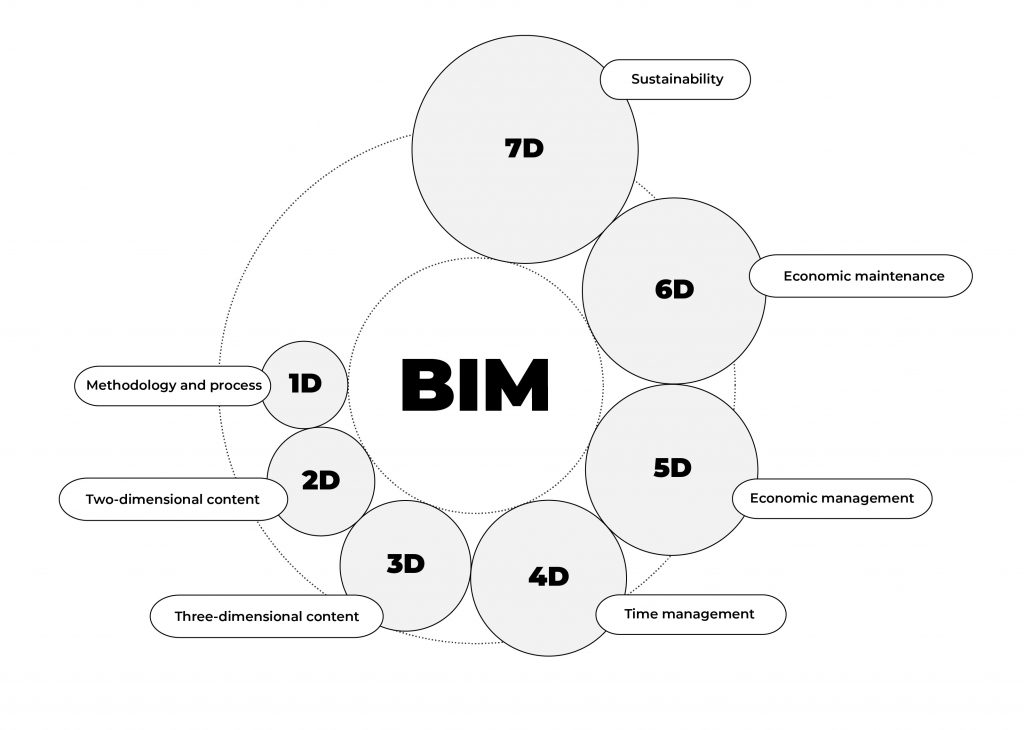BIM METHODOLOGY
Building Information Modeling represents a methodology that has as its goal the digitisation of the construction supply chain, and thus also of infrastructure networks.
Understanding the importance of this paradigm shift, IQT Consulting S.p.A. has been investing in the implementation and application of BIM in the provision of services to the various market sectors for almost a decade.
The BIM methodology focusses on people, processes and tools.
In 2023, IQT Consulting S.p.A. obtained UNI PdR 74:2019 SGBIM: Sistema di Gestione BIM certification, attesting to the adequacy of the processes implemented with respect to the certification scheme.
This process is continuing with the aim, in the coming years, of extending the scope of application of the BIM methodology and related certification also to the IQT Group’s investee companies.

All dimension
of BIM
The BIM methodology is based on defined and standardised procedures that aim to achieve project objectives. In this process, consisting of several micro-steps, it is essential to coordinate and validate the information content through the following procedures:
- Geometric interference checks: through specific clash detection software it is possible to perform interference analysis between the physical components of the model, anticipating any critical issues that may cause delays and increase costs during the work execution step;
- Information inconsistency checks: through specific code checking software it is possible to perform an information check to verify the correctness of the information and compliance with current legislation (e.g. on the sprinkler system)
![]()
From the BIM models performed, complete with qualitative and quantitative information content, graphical and analytical outputs can be extracted that are useful for producing the documentation necessary for representation of the project in two-dimensional formats. In this way, all graphic documentation will have a unique source (BIM model) and, as a consequence, will be coordinated.
![]()
Starting from laser scanner surveys with Trimble and Leica technology, a detailed acquisition of geometric data in the field is carried out, which allows the creation of the BIM model of the actual as is situation.
![]() .
.
Starting from the information model of the work, the design team simultaneously creates the “construction site” model and is able to perform time simulations, with the aim of:
- verifying the progress of the hypothesised construction site,
- promptly identifying any critical safety issues, and
- monitor the progress of the construction site during execution.
![]()
Generation of bills of quantities directly related to the 3D model for proper verification of various cost items and evaluation in economic terms.
![]()
Within the entire process of the construction supply chain, a significant aspect is that of the management of the asset during its use. The facility management area is managed in the BIM methodology with the so-called sixth dimension, 6D. Property or infrastructure assets require an organised and constantly updated collection and use of information and related documents (e.g., data sheets, user manuals, warranties, reports and certifications). A BIM model, developed to the degree of detail that leads to 6D, contains all the information and related documentation that the manager will later need to consult and update in order to maintain the value of his work and to ensure its proper and sustainable use (energetically, economically, and socially).
![]()
The designs performed also include environmental (LCA) and economic (LCC) impact studies, taking advantage of the interoperability between BIM authoring software and One Click analysis software.
Use of the BIM model makes it possible to generate a direct link between the various data related to project components and materials, obtaining an almost immediate simulation of project impacts. This facilitates pursuing the most sustainable solutions (in both environmental and economic terms) during design.
All databases follow the standards defined by EN 15804.
![]()
The information base to be able to trigger data-driven decision-making processes on the digitised asset. Useful to designers, maintainers, builders, owners and managers of the infrastructure.
